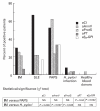Specificity of anti-phospholipid antibodies in infectious mononucleosis: a role for anti-cofactor protein antibodies
- PMID: 10792380
- PMCID: PMC1905654
- DOI: 10.1046/j.1365-2249.2000.01206.x
Specificity of anti-phospholipid antibodies in infectious mononucleosis: a role for anti-cofactor protein antibodies
Abstract
The antigen specificity of anti-phospholipid antibodies in infectious mononucleosis (IM) was studied using ELISA for the detection of anti-beta2-glycoprotein I (beta2-GPI), anti-annexin V, anti-protein S and anti-prothrombin antibodies and TLC immunostaining for the detection of anti-phospholipid antibodies. This technique enabled us to look at antibodies reacting to 'pure' phospholipid antigens in the absence of protein contamination. Sera from 46 patients with IM, 18 with systemic lupus erythematosus (SLE), 21 with primary anti-phospholipid antibody syndrome (PAPS), 50 with Helicobacter pylori infection and 30 healthy blood donors were tested. This study highlights anti-phospholipid antibodies in patients with IM as specific 'pure' anti-cardiolipin antibodies, while in PAPS and SLE patients anti-phosphatidylserine and anti-phosphatidylethanolamine antibodies were also found. This investigation also shows that the anti-cardiolipin antibodies found in IM can be present with anti-cofactor protein antibodies. The higher prevalence of anti-cofactor antibodies found in IM sera than in Helicobacter pylori sera may be due to the immunostimulatory effect and/or the polyclonal activation often observed in course of Epstein-Barr virus infection. However, anti-beta2-GPI and, to a lesser extent, anti-prothrombin antibodies occur with a significantly lower prevalence in IM than in PAPS patients. This finding suggests that these antibodies should be regarded as the expression of the broad autoimmune syndrome involving the phospholipid-binding plasma proteins.
Figures


Similar articles
-
Anti-phospholipid antibodies in HIV infection and SLE with or without anti-phospholipid syndrome: comparisons of phospholipid specificity, avidity and reactivity with beta2-GPI.J Autoimmun. 1999 Nov;13(3):347-55. doi: 10.1006/jaut.1999.0324. J Autoimmun. 1999. PMID: 10550222
-
Prevalence and clinical correlation of anti-phospholipid-binding protein antibodies in anticardiolipin-negative patients with systemic lupus erythematosus and women with unexplained recurrent miscarriages.Arch Pathol Lab Med. 2005 Jan;129(1):61-8. doi: 10.5858/2005-129-61-PACCOA. Arch Pathol Lab Med. 2005. PMID: 15628909
-
Association between the prevalence of antibodies to beta(2)-glycoprotein I, prothrombin, protein C, protein S, and annexin V in patients with systemic lupus erythematosus and thrombotic and thrombocytopenic complications.Clin Chem. 2001 Jun;47(6):1008-15. Clin Chem. 2001. PMID: 11375285
-
[Antiphospholipid antibodies: clinical significance and biological diagnosis].Ann Biol Clin (Paris). 2000 Sep-Oct;58(5):557-74. Ann Biol Clin (Paris). 2000. PMID: 11022099 Review. French.
-
[Association between anti-phospholipid antibodies and thrombotic complications in systemic lupus erythematosus].Rinsho Byori. 2003 Mar;51(3):239-47. Rinsho Byori. 2003. PMID: 12707997 Review. Japanese.
Cited by
-
Thin-layer chromatography immunostaining in detecting anti-phospholipid antibodies in seronegative anti-phospholipid syndrome.Clin Exp Immunol. 2012 Mar;167(3):429-37. doi: 10.1111/j.1365-2249.2011.04532.x. Clin Exp Immunol. 2012. PMID: 22288586 Free PMC article.
-
The antiphospholipid syndrome and infection.Curr Rheumatol Rep. 2001 Aug;3(4):277-85. doi: 10.1007/s11926-001-0031-4. Curr Rheumatol Rep. 2001. PMID: 11470045 Review.
-
Antiphospholipid reactivity against cardiolipin metabolites occurring during endothelial cell apoptosis.Arthritis Res Ther. 2006;8(6):R180. doi: 10.1186/ar2091. Arthritis Res Ther. 2006. PMID: 17150088 Free PMC article.
-
Dimerized Domain V of Beta2-Glycoprotein I Is Sufficient to Upregulate Procoagulant Activity in PMA-Treated U937 Monocytes and Require Intact Residues in Two Phospholipid-Binding Loops.Antibodies (Basel). 2017 Jun;6(2):8. doi: 10.3390/antib6020008. Epub 2017 Jun 2. Antibodies (Basel). 2017. PMID: 28748111 Free PMC article.
-
Antiphospholipid syndrome infectious origin.J Clin Immunol. 2004 Jan;24(1):12-23. doi: 10.1023/B:JOCI.0000018058.28764.ce. J Clin Immunol. 2004. PMID: 14997029 Review.
References
-
- Hughes GRV. The anticardiolipin syndrome. Clin Exp Rheumatol. 1985;3:285–6. - PubMed
-
- Wilson WA, Gharavi AE, Koike T, et al. International consensus statement on preliminary classification criteria for definite antiphospholipid syndrome. Arthritis Rheum. 1999;42:1309–11. - PubMed
-
- Harris EN, Hughes GRV. Antiphospholipid antibodies. In: McCarty DJ, editor. Arthritis and allied conditions. Philadelphia: Lea & Febiger; pp. 1068–79.
-
- Wasserman A, Neisser A, Brock C. Eine serodiagnostische Reaktion bei Syphilis. Dtsch Med Wochenschr. 1906;32:745–6.
-
- Pangborn MC. A new serologically active phospholipid from beef heart. Proc Soc Exp Biol Med. 1941;48:484–6.
Publication types
MeSH terms
Substances
LinkOut - more resources
Full Text Sources
Other Literature Sources
Medical

